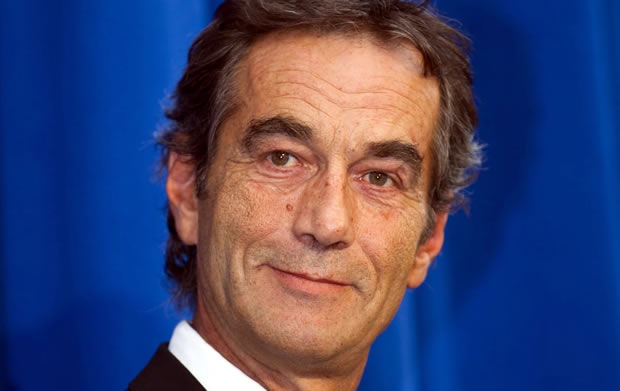
Taking on the 34th America's Cup
With the America’s Cup going catamaran, then it was inevitable that the leading nation for offshore multihull racing should be represented. In fact France at present is the only country fielding two potential challengers for the 34th America’s Cup in the Bertrand Pace-led Aleph and the Peyron brothers’ Energy Team.
The Peyron brothers have been campaigning offshore multihulls for more than three decades.
Bruno, now 56, competed in the first Route du Rhum in 1977 and came second in 1982, but is best known for skippering the maxi cat Commodore Explorer back in 1994 becoming the first ever to win the Jules Verne Trophy for sailing around the world non-stop in less than 80 days. The originator of the present breed of offshore maxi-multihulls, known as the ‘G Class’ and subsequently creator of The Race held in 2001, Bruno has bettered his original Jules Verne Trophy time twice more since 1994. His most recent attempt on Orange 2 in 2005 stood as the benchmark to beat until it finally yielded earlier this year to Franck Cammas and the crew of Groupama III.
Younger brother, Loick, 51, is a more all-round sailor and for a long time was the most successful skipper on the ORMA 60 trimaran circuit, during which time he twice won the OSTAR aboard his Fujifilm trimarans. He has since proved equally adept around the cans in D35s and in the Extreme Sailing Series.
Given that they were very late getting into the AC45s compared to the big three (Oracle Racing, Emirates Team NZ and Artemis), Bruno Peyron says that it was good they were able to hold their own against them in Plymouth. “We are very pleased, because we are a little bit ahead compared to where we expected to be at the very beginning when we decided to do this. We were hoping to reach the big three by mid-season after training and discovering and everything. It is a step-by-step approach for us to discover what this story is, in order to learn and improve.” He admits that they when they started in Cascais they had very bad softsails and also a turnover in crew who had commitments to the Extreme Sailing Series.
Of the new teams to the America’s Cup, Energy Team is the only one with a significant sponsor already on board in the form of Swiss watch manufacturer Corum.
“The fact that we are the only new team to have secured this is a very good sign for the future,” says Peyron. “I’m not saying we are spending a lot. Most of the guys are not yet paid and so on, except the crew, but as soon as we have enough we will pay them back. But it is also a question of the trust that Loick and I have been building over the last 30 years.”
Peyron believes they are the only one of the new steam with the budget now in place to secure their participation on the America’s Cup World Series events over the next two years.
“This is the result of my negotiations last winter to try and make our friends [ie Oracle Racing and ACRM/ACEA] understand that they have no choice but to separate the AC45s from the 72s," he continues. "In the end we were not the only ones to push for this. For me, that was very very important otherwise we would have stopped.” In other words it is now possible to campaign an AC45 on the America’s Cup World Series without definitely having to compete in the 34th America’s Cup itself.
Peyron's principle concern over the new path for the 34th America’s Cup was whether it was genuinely going to be a viable commercial entity. “It had to be obvious that they definitely want that," he says of the organisers. "They have been sometimes late on a few things, but at least they are listening and we congratulations them for the work they have done so far.”
He also pointed out to them that if April 2011 was unrealistic as an absolute deadline for entry into the 34th America’s Cup. “I explained that in real life it is not going to be that way.” By April he hoped to get companies in France to see the 34th America’s Cup as being a possibility, but it would take at least another six months to convince them to sign on the dotted line. “That is life. You have to respect the process in big companies.”
In order to attract partners, Peyron has been smart in calling his campaign ‘Energy Team’. As he says, at the end of the 1990s he identified that the telecoms market would be one of the biggest growth areas in business and so he managed to attract Orange into funding two of his three successful Jules Verne Trophy attempts. Energy is the equivalent now, he believes, and in France this industry obviously already has a track record with the America’s Cup, the French nuclear power giant Areva having backed two French challenges in 2003 and 2007.
At present Corum has the only branding on Energy Team’s AC45 because as Peyron puts it, they had the balls to sign up early. “And they are a good brand and they have been in sailing for years, so they can benefit from more space. Then they will be like the others [when more sponsors come on board]. It is good for the future partners, because Corum is a very good brand.”
In terms of budget, Peyron says he passed his figures by Emirates Team New Zealand boss Grant Dalton (who Peyron knows well having got him the job skippering Club Med in The Race). To carry out a campaign Peyron is aiming for a budget of 20 million Euros/year. “I decided to make it very clear and public that we could do it with exactly the same level of budget as the biggest team in France [ie Groupama 17 million/year] plus a couple of official partners like Corum, etc. This message is very important because it helps to understand it is not any more about private money, which is a very bad image in France.”
Thankfully in France, they are in a relatively good position given the long history of sponsorship in sailing there with large brands like Groupama, Foncia, Veolia Environnement and Banque Populaire still involved. Peyron says it also helps that he and his brother have such a long track record, performing both on the water and with their communication, plus the experience they both have of running big campaigns.
So with a two year campaign Peyron ideally hopes to get one major sponsor in at 35 million Euros, plus a couple more like Corum in at 5-6 million Euros apiece. “Then, I think, we could be at the right level for the AC34,” he says. “Since the very beginning when we started to go we want to build a program over two editions. You don’t win a World Championship in the first year. We wanted to be first among the rookies and here we are [in Plymouth] up with Korea and I hope we will succeed in continuing in that way. We want to get the best result in the semi-final of the Louis Vuitton Cup and be in the best position to prepare for the next one [the 35th America’s Cup]. I think this target is very accessible to the partners.”
Obviously the amount a campaign costs depends upon its duration, which in Energy Team's case is already down to two years for this campaign. Then there is the shopping list. Peyron reckons that the new build of an AC72 is around 5 million Euros and then it depends on whether you can build two boats, the number of wings and foil packages, the R&D that is put in, the sail program, the crew, etc.
For the Energy Team AC72 they intend to buy ACRM’s design starter pack, costing 1.2 million Euros. Then they have their own designers who will develop this. Who is in their design team is not public, but given that Energy Team are likely to build at Multiplast in Vannes (who have built all of Peyron’s maxi-multihulls in recent decades as well as several America’s Cup monohulls) and that leading French multihull architects VPLP (who were also part of the design team that worked on the starter pack) are located right next door to Multiplast, albeit with a large offshore maxi-catamaran (Orange 2) in between, it doesn’t take much to join the dots.
Peyron still owns Orange 2 and he says that if they have some budget then they might rebrand and relaunch the world’s biggest, fastest offshore catamaran and take her to San Francisco to use for PR purposes and for their sponsors.
If they are to go with a two boat program, which Peyron confirms they are still aiming for, then given that a build will take six months (which is fast) he says that they will have to start building by January 2012 latest, based on the Protocol for the 34th America’s Cup stating that teams can only start training on their first boat from 1 July 2012 until 31 January 2013.
If they only go with one boat then they could leave it later. “You still have the question of ‘when’? Do you prefer to have it early and train more or develop it a bit more and train later? If you have your two boats too late, just forget it. If you can have them a lot in advance, with a double campaign... But training the guys on two teams, there it is a lot of extra logistics and cost and so on.”
On the commercial team there remains the issue that a major team being 100% commercially funded has yet to happen in the America’s Cup. Emirates Team New Zealand have gone further down this path than anyone, but they still have backing from the New Zealand government (who’s goal is to return the America’s Cup competition to Auckland) and from their Swiss-Italian private backer, Matteo de Nora and donations from other well heeled individuals.
To help find backing Energy Team has joined forces with the Paris-based Ubi Bene sportz agency which has held the Nike account in France for the last 10 years.
Finally Bruno says he is looking forward to the prospect of his younger brother reclaiming the Jules Verne Trophy for the Peyron family when he skippers the maxi-trimaran Banque Populaire around the world this winter.

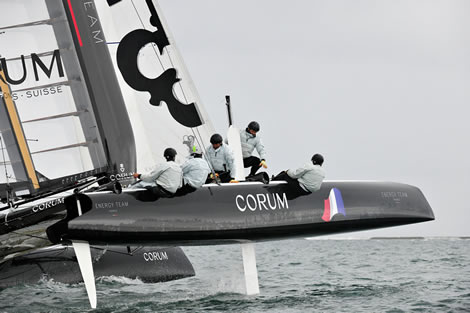
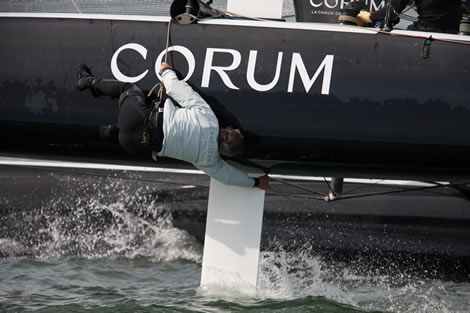
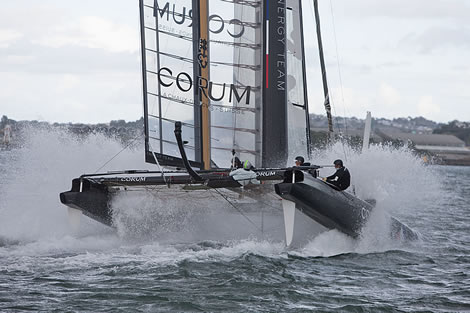
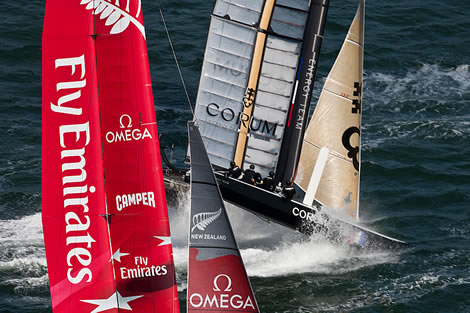








Latest Comments
Add a comment - Members log in